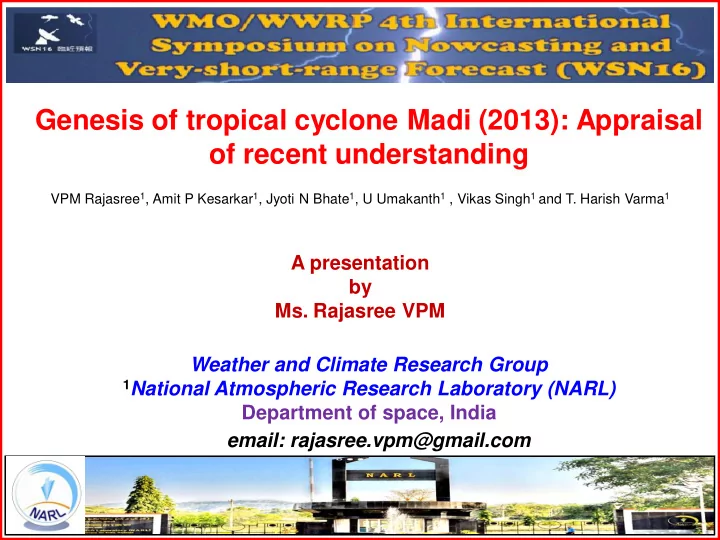

Genesis of tropical cyclone Madi (2013): Appraisal of recent understanding VPM Rajasree 1 , Amit P Kesarkar 1 , Jyoti N Bhate 1 , U Umakanth 1 , Vikas Singh 1 and T. Harish Varma 1 A presentation by Ms. Rajasree VPM Weather and Climate Research Group 1 National Atmospheric Research Laboratory (NARL) Department of space, India email: rajasree.vpm@gmail.com
Scientific problem “The pathway by which cumulus convection organizes to form a large scale tropical cyclone vortex is an unsolved problem in dynamic and tropical meteorology” - Hendricks et al . (2004) Dunkerton et al., 2009 • Marsupial paradigm (H1-H3) Trough Inflow Moist H1- Roll up of vorticity/ wave CL breaking H2- Pouch region H3- Meso-scale vortices DMW 09 Objectives: To test the applicability of marsupial paradigm over NIO Understand the pathway of genesis of Madi (2013) 28 July 2016 WSN - 16 2
Data and methodology IMD best track dataset NOAA/AOML TCHP images MSG satellite images ERA interim reanalysis NCEP ADP upper air and surface observations Satellite Radiances WMO Satellite Sensors Satellite Platform AMSU A NOAA 15,16,18, EOS Aqua and METOP-2 AMSU B NOAA-15, 16, 17 AIRS NOAA-18, and METOP -2 MHS EOS Aqua High resolution analysis is created using 3Dvar assimilation 28 July 2016 WSN - 16 3
Experimental design Details Configuration Weather Research and Forecasting - WRF (Version 3.6.1) & WRFDA Dynamical core ARW, compressible, Non-hydrostatic Horizontal grid 18km(Domain 1), distance 6km (Domain 2) Vertical levels 64 Model top 100 hPa Initial and boundary GFS analysis (0.5 x conditions 0.5), 6 hourly Time step 30 s Microphysics Thompson Long wave radiation RRTM Short wave radiation Dudhia scheme Surface layer Monin Obukhov similarity theory Land surface Noah Land surface PBL Mellor Yemada Janjic Cumulus Kain-Fritch scheme 28 July 2016 WSN - 16 4
Simulation verification Track Wind speed CSLP IMD in green and 3Dvar analysis in red Formed on Dec 6 and dissipated on Dec13 Category 1 on Dec 8; 986 hPa and 65kt Unique track with near northerly movement 3Dvar analysis shows matching track and the recurvature of Madi cyclone also well simulated. 28 July 2016 WSN - 16 5
Large scale conditions MSG satellite image SST and TCHP CAPE & CINE 04Dec2013, Warm water SST> 26.5 ° C, TCHP > 100KJcm -2 , CAPE > 2500 Jkg 1 28 July 2016 WSN - 16 6
Large scale conditions Deep layer shear 850hPa vorticity Favorable conditions for genesis 28 July 2016 WSN - 16 7
Genesis sequence of Madi (2013) – H1 Tracking parent disturbance Tropical cyclone Madi’s precursor disturbance originated from a westward moving disturbance and it is tracked for 15 days prior to TD declaration. Phase speed of propagation is -7.2 ms -1 28 July 2016 WSN - 16 8
Pouch formation – H2 TPW 850hPa vorticity Pouch is identified as a region of enhanced moisture 28 July 2016 WSN - 16 9
Pouch formation – H2 OW parameter Madi forms in a rotation dominant region 28 July 2016 WSN - 16 10
Intensification of convection – H3 IRBT Vertical velocity Latitude Rain rate Longitude Proto-vortex is intensified by convective activity (H3) 28 July 2016 WSN - 16 11
Pathway of genesis of Madi (2013) Profiles Hovmoller v Closely follows the bottom-up pathway 28 July 2016 WSN - 16 12
Pathway of genesis of Madi (2013) Vorticity Warm core Closely follows the bottom-up pathway 28 July 2016 WSN - 16 13
Role of VHTs on genesis of Madi (2013) Absolute vorticity Diabatic heating Diabatic vortex mereger in the genesis environemnent 28 July 2016 WSN - 16 14
Role of VHTs on genesis of Madi (2013) Potential vorticity Vorticity budget 28 July 2016 WSN - 16 15
Role of VHTs on genesis of Madi (2013) Diabatic heating Vertical velocity Diabatic heating rate is dominated by the latent heating in the convective updrafts 28 July 2016 WSN - 16 16
Conclusions The paper presents the comprehensive analysis of the genesis sequence of a very severe cyclonic storm Madi over the BoB region to examine the applicability of recent concepts and theories of cyclogenesis. For this purpose, we have generated high resolution analysis using meso-scale model WRF and available data sets viz. satellite data and in- situ weather observations, using 3DVAR data assimilation technique. Additional data sets used include ERA-interim reanalysis, IRBT observations, MSG and TRMM 3B42 rainfall observations. The parent disturbance responsible for genesis of tropical cyclone Madi is tracked from fifteen days prior to the period of genesis in the developed high resolution analysis. The closed cyclonic circulation protects the Madi precursor from all kinds of deformations and acts as a “pouch region” associated with the parent disturbance. 28 July 2016 WSN - 16 17
Conclusions Large scale priming of environment agrees with the hypotheses of the marsupial theory of tropical cyclogenesis. Our results indicate that, development of warm core inside the pouch region is continuous process about two days prior to actual time of cyclogenesis . The diabatic heating more than 10 K h -1 and collocated increase in the vertical velocity more than 0.5 ms -1 is evident in the genesis environment of Madi cyclone. These convective vortices tilts and converges under the influence of the low level absolute vorticity to form the low level cyclonic circulation leading to the genesis of tropical cyclone Madi. Our investigation suggests that the bottom-up mechanism was operational for the genesis of tropical cyclone Madi. Rajasree et al., 2016, JGR 28 July 2016 WSN - 16 18
28 July 2016 WSN - 16 19
Recommend
More recommend